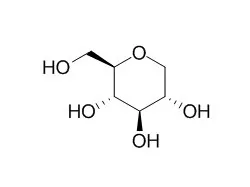| In vivo: |
| J Diabetes Complications. 2014 May-Jun;28(3):348-52. | | Association of reduced levels of serum 1,5-Anhydro-d-glucitol with carotid atherosclerosis in patients with type 2 diabetes.[Pubmed: 24560424] | HbA1c level represents mean blood glycemic control. 1,5-Anhydro-D-glucitol (1,5-AG) level reflects glycemic fluctuations, a strong risk factor for the development of macroangiopathy. The present study investigated the relationship between serum 1,5-AG levels and macroangiopathy in patients with type 2 diabetes.
METHODS AND RESULTS:
A total of 115 consecutive patients with type 2 diabetes, aged 45-79 years, were included. HbA1c, 1,5-Anhydro-D-glucitol, and lipid profile were measured. Carotid maximum intima-media thickness (IMT) and plaque score (PS) were determined by carotid sonography. An 1,5-Anhydro-D-glucitol level < 14.2 μg/mL was used as a predictor of a post-challenge 2-h blood glucose level > 200 mg/dL. Patients were divided into four groups: A (n=32), HbA1c ≥ 6.5% and 1,5-Anhydro-D-glucitol<14.2 μg/mL; B (n=23), HbA1c ≥ 6.5% and 1,5-Anhydro-D-glucitol ≥ 14.2 μg/mL; C (n=24), HbA1c < 6.5% and 1,5-AG <14.2 μg/mL; and D (n=36), HbA1c < 6.5% and 1,5-Anhydro-D-glucitol ≥ 14.2 μg/mL. HbA1c level had significant positive correlation with IMT and PS. 1,5-AG level had a significant negative correlation with PS. PS was significantly higher in group C than in group D, but similar to that in group B. In multivariate analysis, HbA1c (β=0.27, p=0.03) and 1,5-AG (β=-0.24, P=0.04) were independent determinants of PS.
CONCLUSIONS:
1,5-Anhydro-D-glucitol level might provide additional information to identify macroangiopathy of patients with type 2 diabetes, especially in those with excellent HbA1c levels. | | Cardiovasc Diabetol. 2014 Jun 13;13:99. | | Low levels of 1,5-anhydro-D-glucitol are associated with vascular endothelial dysfunction in type 2 diabetes.[Pubmed: 24924149] | Vascular endothelial dysfunction is involved in macrovascular disease progression in type 2 diabetes mellitus (T2DM). We reported previously that blood glucose fluctuations, as evaluated by continuous glucose monitoring (CGM), correlate with vascular endothelial function, serving as a marker of vascular endothelial function. However, the use of CGM is limited, suggesting the need for another marker of vascular endothelial function. Here, we investigated the relationship between vascular endothelial dysfunction and blood levels of 1,5-Anhydro-D-glucitol (1,5-AG), a marker of both postprandial hyperglycemia and fluctuations in blood glucose.
METHODS AND RESULTS:
In 32 inpatients with T2DM and HbA1c less than 8.0%, the reactive hyperemia index (RHI), an index of vascular endothelial function, was determined by peripheral arterial tonometry. The relationships between RHI and 1,5-Anhydro-D-glucitol , blood glucose, lipid metabolism markers, and blood pressure, were examined. There was a strong correlation between 1,5-Anhydro-D-glucitol and natural logarithmic-scaled RHI (L_RHI) (r = 0.55; P = 0.001). However, there was no correlation between L_RHI and HbA1c, fasting blood glucose, IRI, LDL-C, HDL-C, TG, systolic blood pressure, or diastolic blood pressure. Multivariate analysis identified blood 1,5-Anhydro-D-glucitol levels to be the only significant and independent determinant of L_RHI.
CONCLUSIONS:
In T2DM with HbA1c <8.0%, low 1,5-Anhydro-D-glucitol levels were associated with vascular endothelial dysfunction, suggesting it is a potentially useful marker for vascular endothelial dysfunction. |
|






 Cell. 2018 Jan 11;172(1-2):249-261.e12. doi: 10.1016/j.cell.2017.12.019.IF=36.216(2019)
Cell. 2018 Jan 11;172(1-2):249-261.e12. doi: 10.1016/j.cell.2017.12.019.IF=36.216(2019) Cell Metab. 2020 Mar 3;31(3):534-548.e5. doi: 10.1016/j.cmet.2020.01.002.IF=22.415(2019)
Cell Metab. 2020 Mar 3;31(3):534-548.e5. doi: 10.1016/j.cmet.2020.01.002.IF=22.415(2019) Mol Cell. 2017 Nov 16;68(4):673-685.e6. doi: 10.1016/j.molcel.2017.10.022.IF=14.548(2019)
Mol Cell. 2017 Nov 16;68(4):673-685.e6. doi: 10.1016/j.molcel.2017.10.022.IF=14.548(2019)